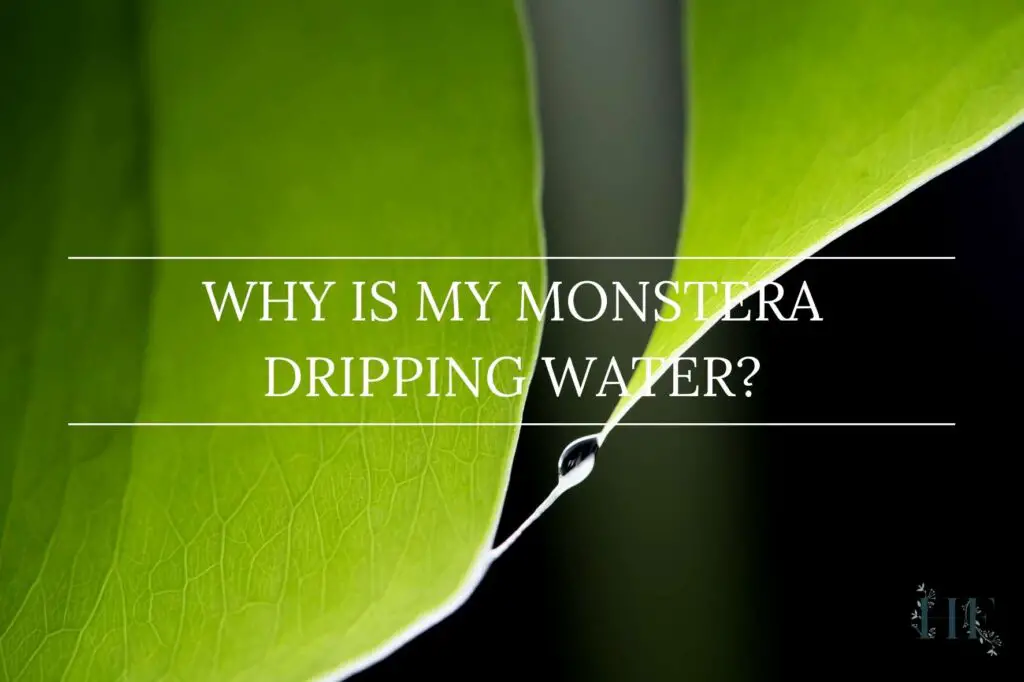The first time I spotted my Monstera Deliciosa dripping water, I was puzzled. Why does my Monstera have water drops?
A Monstera has water on leaves, also referred to as dripping, sweating and even crying, due to guttation, a non-harmful, natural process. However, it can occur due to different reasons like overwatering, overfertilising, plant stress, etc.
Discover more reasons why a Monstera has water drops on leaves and how to distinguish between guttation, dew, and sticky residue caused by harmful pests to make sure your Monstera is happy and healthy.
Monstera Dripping Water
Why Is My Monstera Dripping?
Your Monstera plant is likely dripping water because of a phenomenon known as guttation.
Guttation, which is referred to as “dripping,” “sweating,” “weeping,” or “crying,” is a completely natural process where liquid droplets form on the tips or edges of perfectly healthy leaves.
While the droplets look like water, it is actually a combination of excess water and minerals called xylem sap.
Insider Tip: Xylem sap is not toxic and will not harm your furniture or floors. However, if larger Monstera plants start guttating, (i.e., dripping), it can get quite messy.
Guttation happens when your Monstera plant has a little more water than needed and finds a way to get rid of the excess.
The roots end up absorbing water in excess from the soil. Since plants usually turn off their transpiration processes at night (the stomata or leaf pores are closed in the absence of light), the accumulation of water in the roots creates enough root pressure to push the water upwards.
As water moves up the plant, it picks up excess salts and minerals, forming the xylem sap.
When the xylem sap reaches the guttation cells located on the edges of Monstera leaves, it gets released as droplets on the tips of your Monstera plant’s leaves.
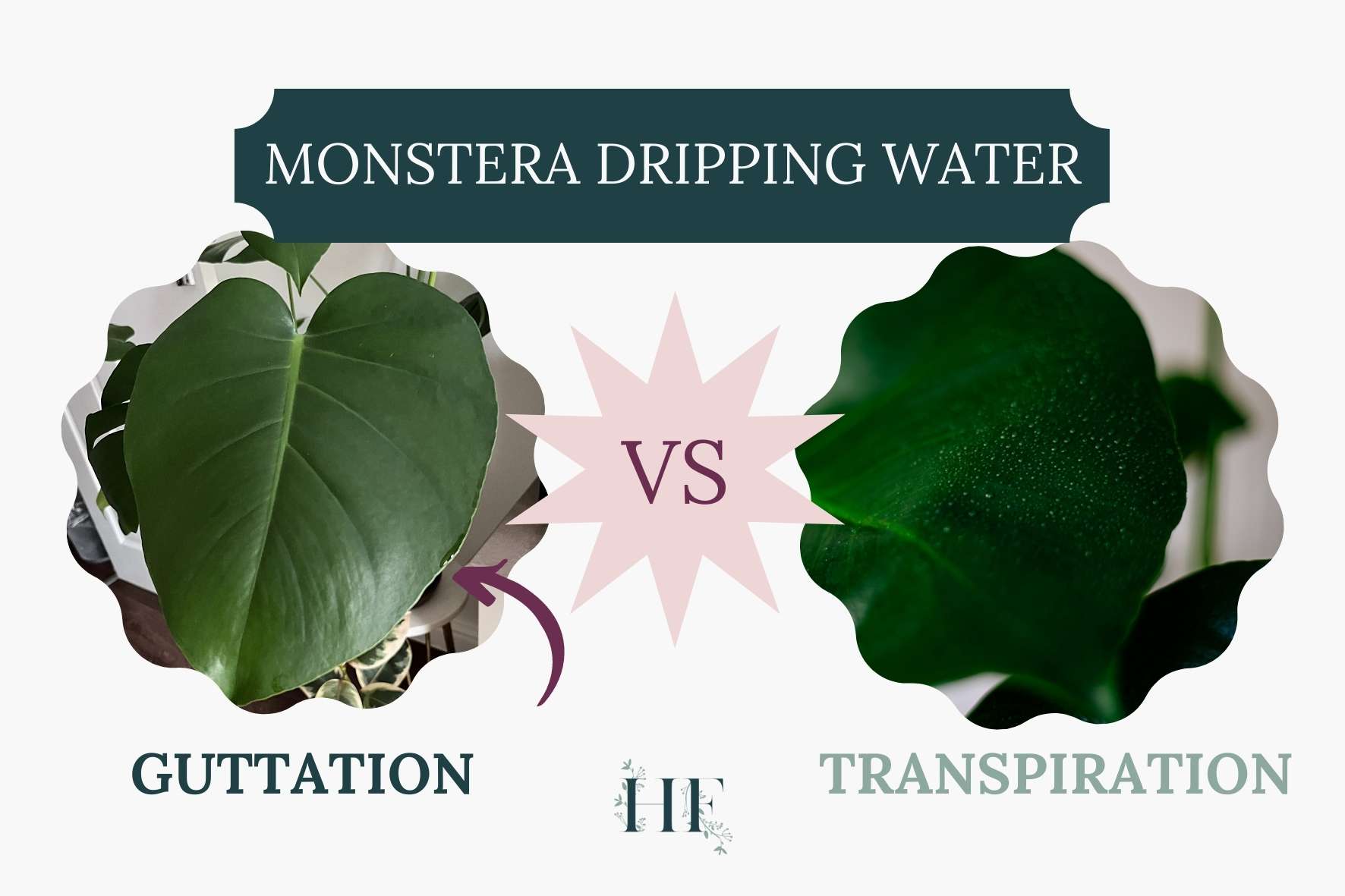
Guttation vs Transpiration
Guttation and transpiration are not the same things.
Transpiration happens during the day at high temperatures and occurs when moisture or water leaves your Monstera in the form of a vapour. This moisture leaves your plant via the stomata (leaf pores) situated on the underside of its leaves since it opens to allow evaporation during the day.
Guttation, on the other hand, is xylem sap that is secreted from the plant itself. Guttation occurs when the plant itself forces water out of the leaves and it happens at night.
So, you might be able to spot some water drops on the edges of your Monstera leaves first thing in the morning (that’s how I discovered that my Monstera was dripping!)
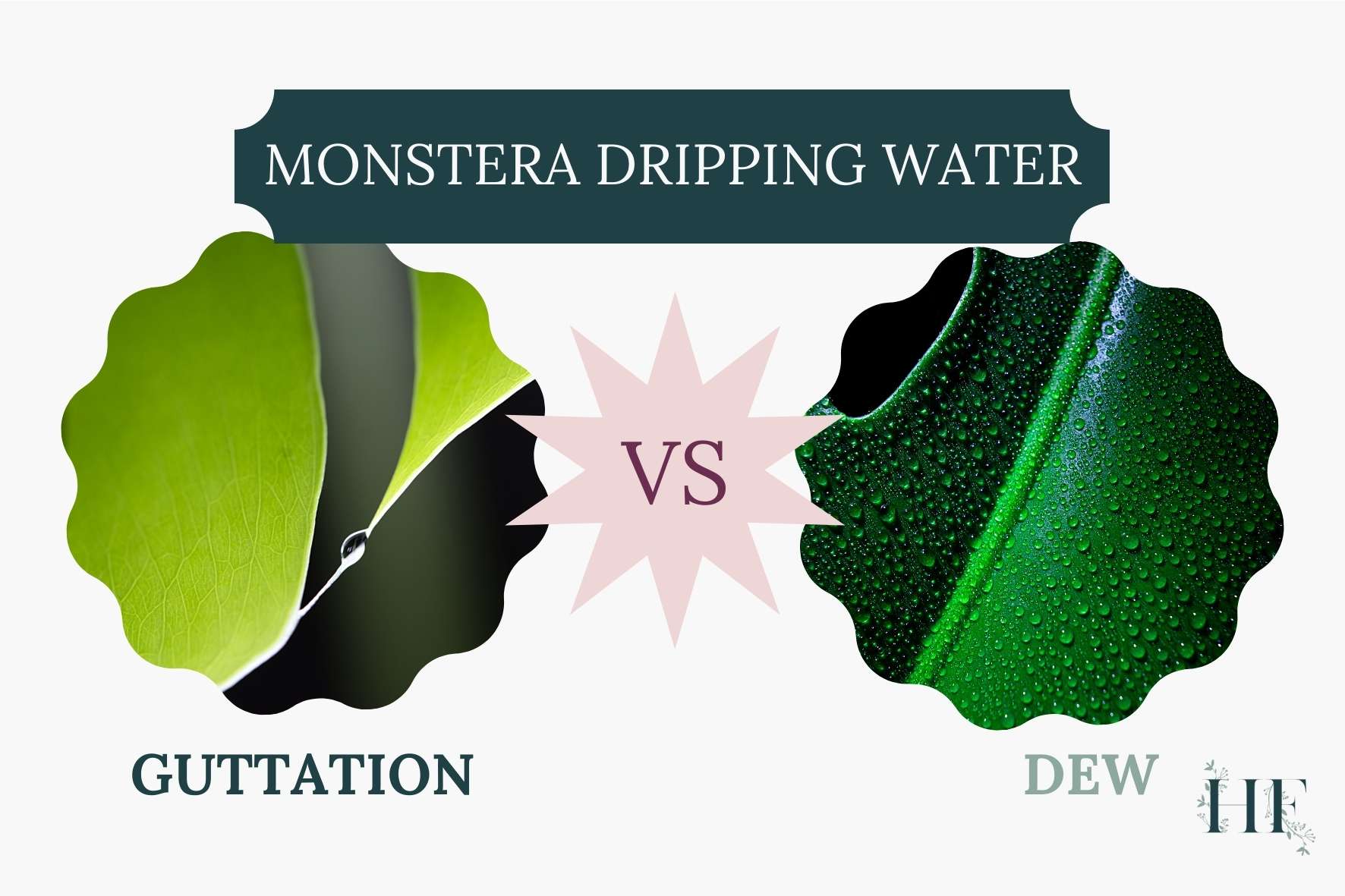
Guttation vs Dew
Dew forms when the temperature outside cools down and the air cannot hold any more water vapour. This moisture then condenses on surfaces like your Monstera leaves, in the form of dew drops.
The easiest way to distinguish between the two is by closely looking at the plant’s leaves.
Dew is evenly distributed across the surface of a Monstera’s leaves. This is because dew is formed by the air, not the plant itself.
Guttation will appear as beads of moisture (water drops) at the tip or edge of the Monstera leaves.
Dew occurs mostly with outdoor plants while guttation is more common with indoor plants. This is because indoor plants that are often placed in environments with high humidity, like bathrooms or kitchens.
Insider Tip: You can always use a hydrometer to keep an eye on the humidity levels around your Monstera plant. I recommend and use ThermoPro Digital Hygrometer, which also measures the room temperature.
For growing your Monstera plant at the best humidity levels, check out Monstera Humidity & Temperature Needs – 7 Tips to Get It Right.
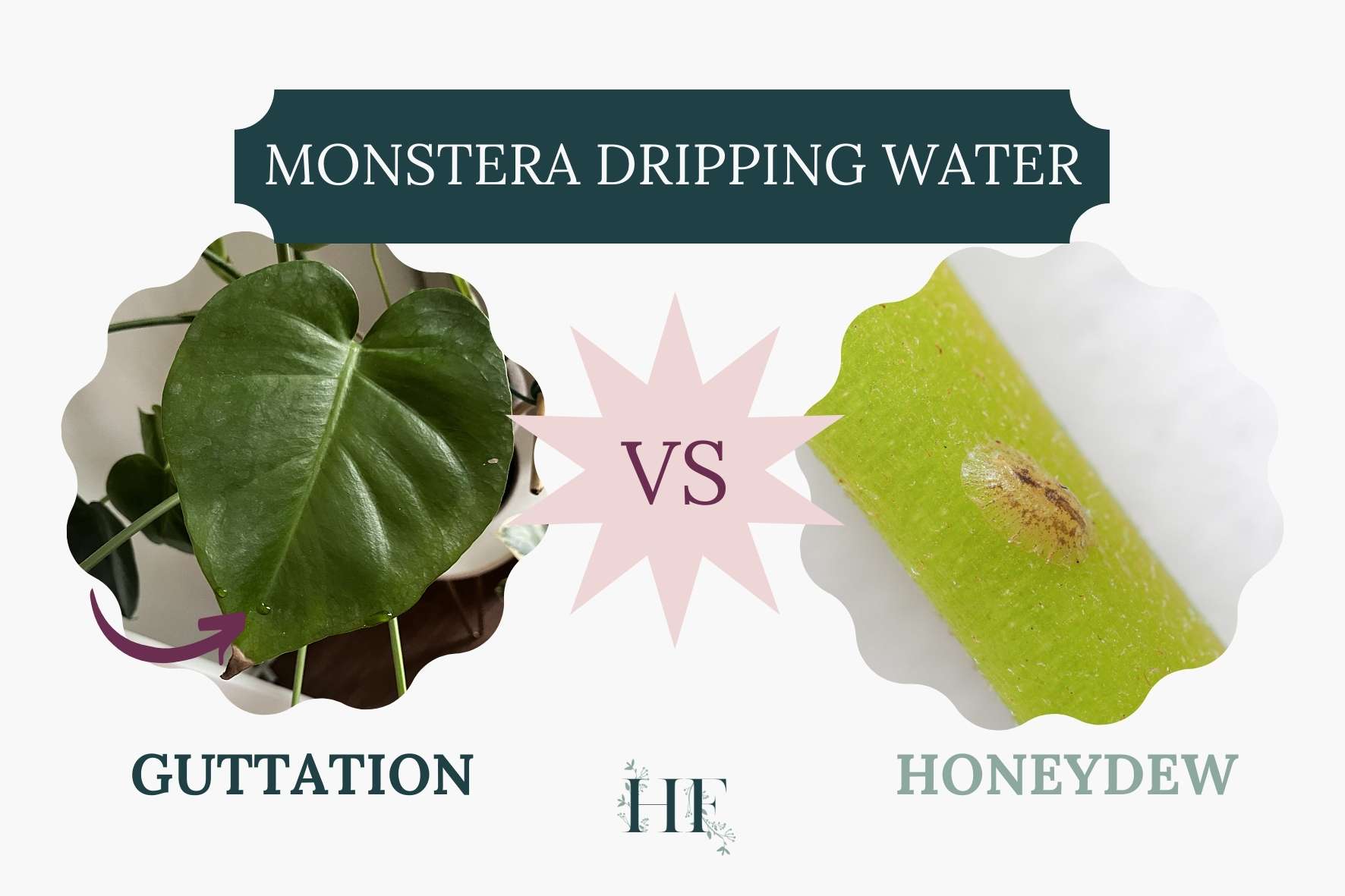
Guttation vs Honeydew
Plant pests can leave behind a sticky secretion (referred to as honeydew), which sometimes gets confused with guttation. It is important to recognize the difference as pests are harmful and should be dealt with immediately.
Honeydew is a clear, sticky substance left behind by pests like mealybugs, mites, and especially scale insects. This sap comes from the sugars and other nutrients within the plant, which the pests feed on and then excrete.
While honeydew is not harmful, pests are – they feed on your plant, slowly weakening and eventually killing it (if no action is taken). To make matters worse, honeydew attracts other bugs like ants. (Something you don’t want inside your home! I have been there and it’s not fun).
So, if you notice a sticky substance on your Monstera’s leaves or stems, examine your plant thoroughly. If you find any pests, act as quickly as possible to contain and get rid of them.
Find out more about which types of pests are common to Monsteras here.
Is It Normal for Monstera to Sweat?
Guttation is a natural and common process in Monstera plants. Your plant is simply getting rid of excess water through tiny holes called hydathodes which can be found at the tip of the leaf.
This isn’t an indication that your plant is sick or needs more water. In fact, it’s quite the opposite. Your Monstera is likely getting too much water since it’s getting rid of the excess moisture.
While guttation is a normal occurrence, it’s important to be aware of how often it’s happening. If your Monstera plant is dripping constantly, that means that you might need to asses and change your Monstera’s living conditions so that it can regulate its water intake.
Continue reading to find out how to address your Monstera’s environment.
Other Causes of Monstera Guttation
Even if it’s a normal process, you might be wondering… Why is my Monstera always wet?
When guttation happens too often, it means that your Monstera is struggling to regulate its water intake. So, something needs to be adjusted or changed.
Here are other facts that can cause guttation in Monstera plants:
1) Overwatering
Does guttation mean I am overwatering my Monstera?
Guttation can sometimes be a sign of overwatering as the roots are absorbing too much water. This is likely if you see guttation happening frequently.
When your Monstera is overwatered, the roots are unable to take in all of the water and it begins to build up in the leaves.
Look for other signs of overwatering such as wet soil, yellowing leaves, and soft dark brown spots. The best way to confirm whether you overwatered your plants is to check if the soil is too wet is by using a moisture meter (this is the one I use).
Once you confirm that guttation is due to overwatering, cut back on watering and allow the soil to dry out completely between waterings.
Read also: Is My Monstera Overwatered or Underwatered? Signs & How to Fix and A Guide to Monstera Water Needs (How Often and When).
2) Over-Fertilising
Another cause of guttation is over fertilisation, especially if the droplets caused by guttation leave white, ink-blot type marks.
When you over-fertilise your Monstera, there’s a build-up of water and nutrients that pressure the roots and eventually result in guttation.
However, because xylem sap is a combination of minerals and water, sometimes white crust forms naturally and may not be a sign of over-fertilisation.
You can look for other signs of over-fertilising such as a white crust on the top of the soil (the next most obvious sign), wilting leaves and stunted growth.
If you suspect that you have over-fertilised your Monstera, you can reduce the frequency and/or amount of fertiliser you feed it. Alternatively, you can switch to a gentler option (like this organic fertiliser).
It’s important to correct this issue as soon as possible since over-fertilising your plants causes fertiliser burn.
Read also: A Guide to Monstera Nutrients (Why, When and How to Fertilise).
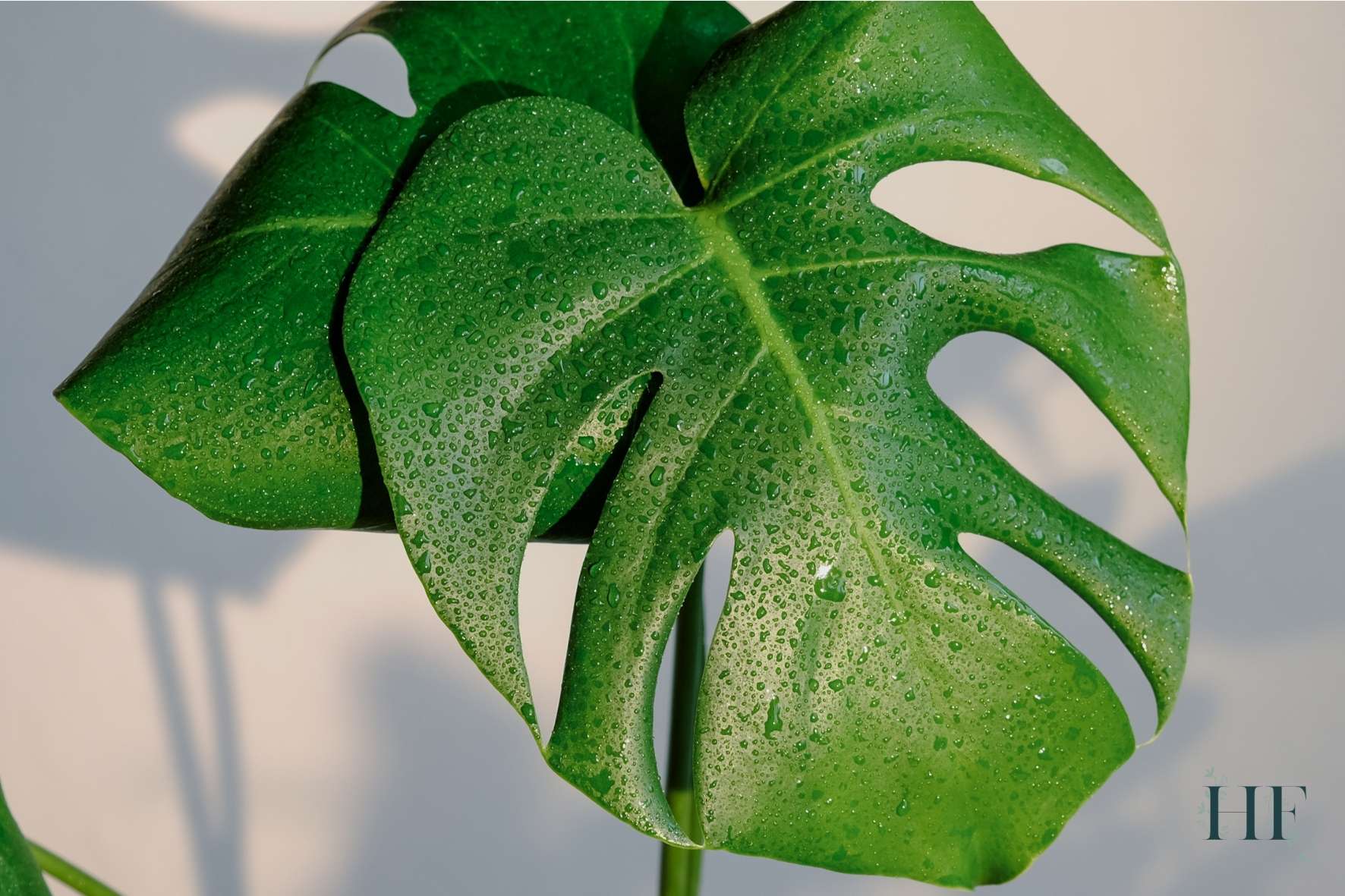
3) Stress or Growing Condition Changes
Stress and growing conditions that are less than ideal can also cause a Monstera to start dripping as well.
Even if you are doing your best to ensure a happy plant, there are a number of factors that can stress your Monstera, including repotting, temperature changes, a new location and even the journey home from the plant nursery.
Adapting to a new environment is a process that some plants handle better than others, and dripping leaves or guttation is one way your Monstera attempts to regulate its growing conditions.
Determine if there have been any environmental changes to cause guttation and allow your Monstera a few days to recover and adjust.
4) Root-Bound
Your Monstera will also start dripping if it’s root-bound in order to get rid of some of the pressure on the root system.
If your Monstera is root-bound, the roots have taken over the entire pot. Due to the lack of soil, there is nowhere else for the water to go, so your Monstera can go through guttation to get rid of the excess moisture.
A clear sign of root-bound is if your Monstera’s roots are growing through the drainage holes in the plant pot. This usually happens when the pot is too small for the size of your Monstera plant.
You should repot your Monstera as often as necessary in order to prevent it from becoming root-bound. In general, Monstera plants need to be repotted every 2 to 3 years or whenever they show signs of stunted growth due to being root-bound.
Read also: A Guide to Repotting Monstera (When, Why and How).
What to Do If Your Monstera Is Sweating
While guttation will not harm your plant, there are steps you can take to avoid water droplets on your Monstera’s leaves.
Adjusting the following factors can help reduce the amount of sweating (each factor includes a link to my guide for that topic):
1) Water Less and In The Morning
Adjusting your watering routine can make a difference in how much your Monstera drips since overwatering is one of the main causes of guttation.
Using less water each time you water your plant will leave less excess moisture around the roots.
Also, you can try watering in the morning so your Monstera has all day to use up the excess water while its stomata are open. This gives the plant time to absorb the water its needs and evaporate the rest as the heat picks up throughout the day.
Once you confirm that guttation is due to overwatering, cut back on watering and allow the soil to dry out completely between waterings.
Find out more: A Guide to Monstera Water Needs (How Often and When).
2) Change the Potting Mix
A well-draining potting mixture will distribute water evenly and let the excess flow out. Both orchid bark chips and perlite are great for drainage and aeration, which will help prevent guttation.
Monstera plants do best in well-drained and aerated soil. They prefer a slightly acidic soil type, with its pH in the range of 5.5 to 7.
A potting mix containing orchid bark chips, coconut coir, perlite, and worm casting, apart from the soil, is a perfect mix for the Swiss Cheese Plants.
You can achieve this in a few ways, here are some recommendations:
- A mixture of indoor potting soil (10%), orchid bark chips (25%), loose coco coir (20%), perlite (25%), activated charcoal (10%) and some organic matter like worm castings (10%).
- A ready-to-go mix of coco coir and perlite (50%) and houseplant compost (50%).
- There’s also a Monstera-specific potting soil available on Amazon.
Find out more: Which Type of Soil Is Best for Monstera?
3) Regulate the Temperature and Humidity Levels
Both temperature and humidity affect guttation. So, you can regulate those by keeping your Monstera at a consistent temperature and lowering the humidity in the room.
If the room is too warm, your Monstera will sweat more. If the room is too cold, your plant will sweat less. Also, lower humidity allows more water to escape your Monstera’s leaves via evaporation.
The ideal temperature range for an indoor Monstera is between 20 to 30°C (68–86 °F). Also, Monstera plants need their humidity levels between 40% to 60%.
One way to keep an eye on the temperature and humidity levels is by using the hydrometer I mentioned before.
You can also regulate the temperature and humidity using an automatic thermostat, which will keep the room temperature at a consistent level and you can set the humidity to a lower number (if your thermostat includes this feature).
If you are using a humidifier or pebble trays, you can remove them altogether or reduce your Monstera’s exposure to them.
Another way to reduce humidity is to move your Monstera away from other plants. This is because when plants are placed very closely together, they create a humid environment.
Find out more: Monstera Humidity & Temperature Needs – 7 Tips to Get It Right.
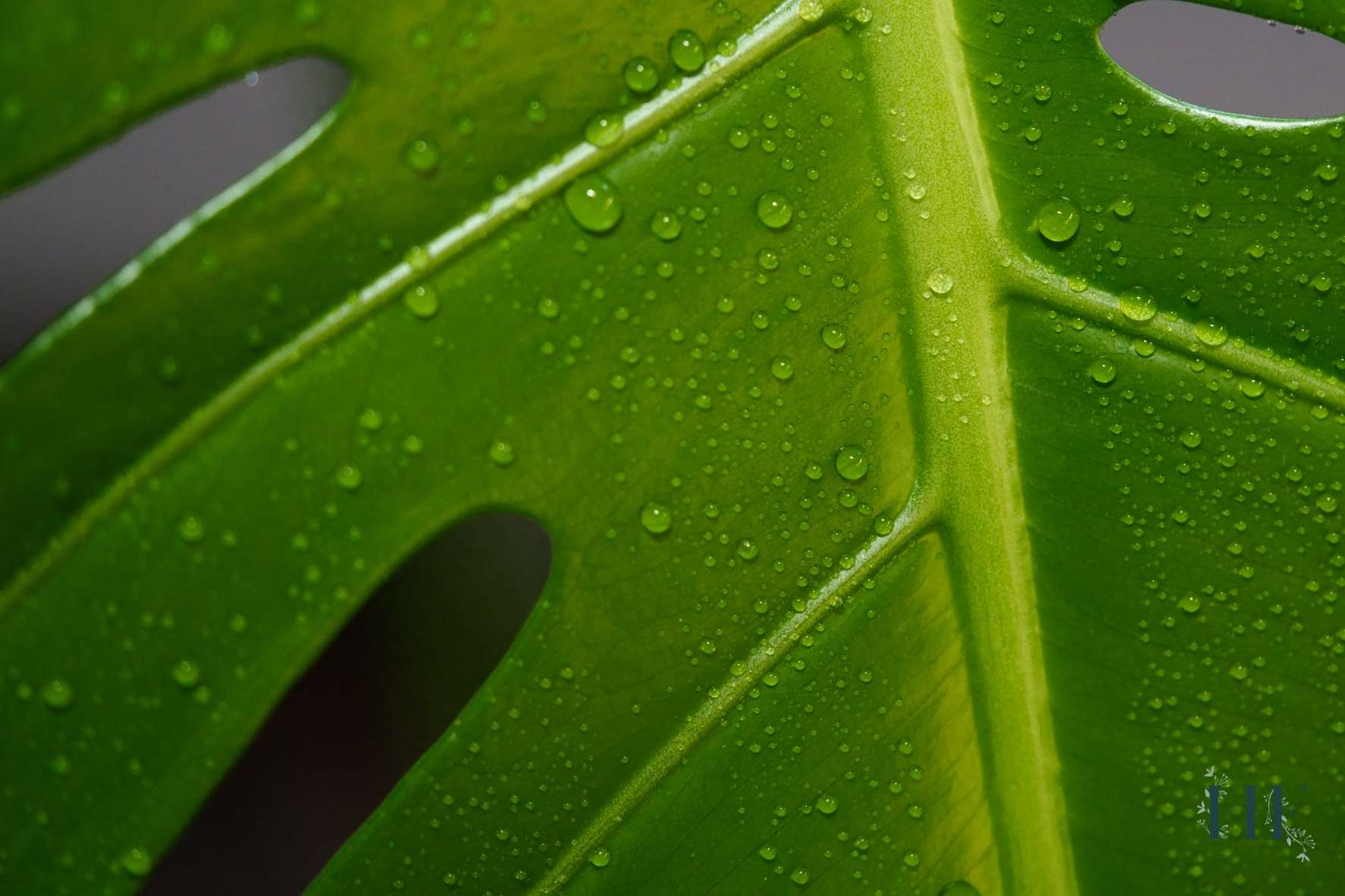
4) Introduce More Light to Your Monstera
More light keeps your Monstera’s pores open longer, allowing water to evaporate. Plus, it helps your plant use up water during photosynthesis.
Monsteras need bright, indirect sunlight for a minimum of six hours a day. So, if your plant is not getting enough light (taking both intensity and duration into account), you can:
- Move it to a brighter spot. A location that receives bright indirect light 2 to 4 feet (0.6 to 1.2 m) removed from a southern or eastern facing window is ideal.
- Supplement natural light using grow lights (like this full-spectrum grow light or a Sansi bulb if you already have a lamp).
Find out more: Monstera Light Requirements – How Much Does It Need?
5) Repot Your Monstera Every Two to Three Years
A root-bound Monstera is likely to drip more often, so consider repotting your Monstera. By repotting, you will reduce some of the pressure on the root system.
As mentioned before, Monstera plants need to be repotted every 2 to 3 years or whenever they show signs of stunted growth due to being root-bound.
Also, the best time of year to repot your Monstera plant is in the early spring, just as its growing season approaches. During this time, your Monstera has the greatest chance to adjust to the new conditions in a different pot and fresh soil.
Every year or two, you could check the roots to see if they are sticking out the drainage holes.
Find out more: A Guide to Repotting Monstera (When, Why and How).
6) Choose an Appropriate Pot Size and Material
Finally, the size and type of pot you use for your Monstera can affect the soil moisture.
Monstera needs a pot with plenty of drainage holes that will allow the soil to drain freely. The material you choose for your Monstera’s pot will depend on factors such as your watering habits, and the temperature and climate where it lives in.
For instance, if you tend to overwater your Monstera, an unglazed terracotta is ideal since its porous and will wick away extra moisture.
In terms of pot size, when repotting, choose a pot that is 2 inches (5 cm) wider in diameter from the current pot size. This is enough for the roots to have room to grow and expand, but not too much that the soil will become waterlogged and lead to root rot.
Find out more: How to Choose the Best Pot for Monsteras & 10 Planter Ideas.

